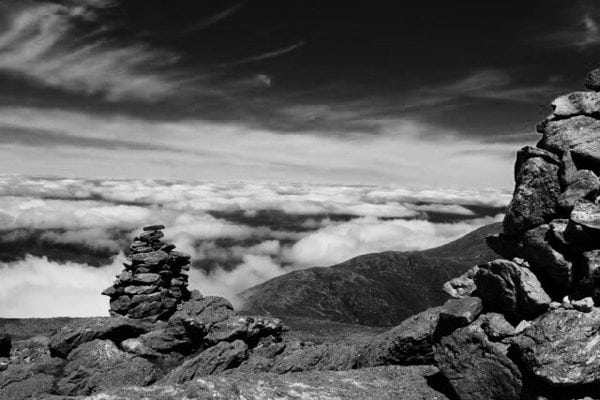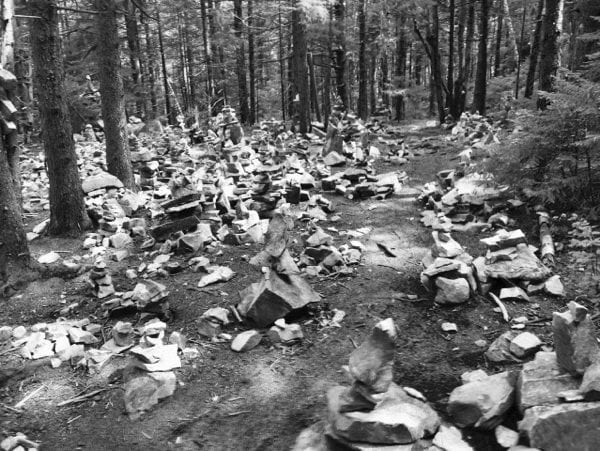Departing the car on what seemed like a bluebird day, it was to my surprise that just a few hours later as I crested the ridge into an open alpine area, I was greeted by high winds and increasing fog. With a cold front moving through, the wind gusts brought tears to my eyes while producing what felt like an ice-cream headache. Alone, I internally debated turning back, but knew that would require descending a section that made me squeamish even in good weather. That in addition to my inner stubbornness for wanting to see this loop through to fruition made my decision seamless. I pressed on, trying to make quick work of the terrain to get back below treeline before the weather worsened. I squinted to see better as I struggled to stay upright while I traversed along the rock-covered ridge. It seemed that each gust resulted in me veering several steps off course in an attempt to keep the rubber side down, and somewhere in the midst of this scrambling I lost the white blazes on the rock, this trail’s markers.
Wincing to shed the moisture from my eyes I stopped dead in my tracks and finally acknowledged the reality that the ridge was entrenched with fog. With no blaze in sight, I felt hyper sensitive to the wind as it cut through my sweat-soaked tech shirt. As goose bumps streamed up and down my body I knew I needed to think quickly. Trying to stay warm I sat on my heels, shielding my eyes with my left hand and scouring my surroundings for a white blaze or landmark to help orient me. This approach yielded no insight, but I knew I needed to start moving to keep warm. Instinctively I relied on my internal compass and started making my way down the rock in what I felt was a northwest direction. I had run this route many times before and I knew the angle my feet should be cutting across the rock. This was a bit of a gamble though, as I didn’t know exactly where my starting point was. I focused my eyes almost straight down at my feet to avoid the wind. Then glancing upward for a second at eye level, I saw what appeared to be a cairn, a pile of rocks used to mark a trail. A sense of calm came over, and I felt a little giddy as I gained reassurance with this cairn that I was indeed headed in the right direction.
Still exposed and bogged down with fog I made quick work of the downward slope to the rock pile. I searched the surrounding area for a blaze, not once or twice but three times, only to realize that this was not in fact a cairn, this was someone’s art project, spiritual monument, or way of saying they had been there—a stack of rocks not created by trail builders or maintainers to mark the way but one that looked exactly like that. In the moment the idea of this mimicry was preposterous to me, but I decided to once again orient myself using the pitch of the rock. With each foot strike my jaw clinched tighter with internal anger. Navigating in the mountains had become a game and I had been fooled. I had been given false hope with that false cairn and my wellbeing was at stake.
Eventually my internal compass got me back on the trail and in the protection of the trees, but after this incident my eyes and emotions increasingly took note of unofficial ‘rock piles’ and ‘rock stacks’ As I traveled on the more widely used trails I found them laden with rock stacks where the trail is straightforward, and in other situations I noted rock stacks that were built to signal a place to go off trail to catch a view. These practices and the one that I encountered on my mountain run misrepresent cairns. Cairns are used across the world to indicate the location of a trail, including here in the Eastern U.S. where the trail might not be obvious in bad weather or winter conditions. I rely on them, others rely on them too, and my mishap while out mountain running has helped me to understand that this trend of people stacking/piling rocks impacts personal safety while also dismissing Leave No Trace’s ethics of leaving what you find as you find it out in the natural world.
In all honesty when this trend started years ago and when I would pass a rock stack, I was intrigued as I studied the balance work of the structure while considering the patience of the builder. At the time I didn’t consider what would happen if one rock stack became two and if they kept multiplying. And I also didn’t consider the negative impact that this practice has on nature. It may sound minor, but moving rocks can increase soil erosion and potentially disrupt a home for an animal or insect. It all adds up!
Have you thought about this topic? For me it unfortunately took a mishap in nasty weather to better grasp the importance of cairns and to further contemplate the increasing epidemic of rock stacking. Now it is very clear that rock stacks, like trash, will remain until they are taken down or broken down slowly by the environment. Nature exists in a certain way for a reason and we should not alter these sacred gifts. I ask that when retreating from civilization and entering nature, let go of the human ego and let nature change you, instead of you changing nature. Take a stand and help end this invasive practice. Worship the wild, and if you find the desire to stack rocks, for whatever reason, please do it on your private land.
Call for Comments (from Meghan)
Aliza would like to know your opinions on the topic of rock stacking. Leave your thoughts in the comments section and join the discussion. Thanks!



